For a food that begins with just flour, water or sometimes eggs, there are infinite variations of pasta. So what happens when you convene a panel of five Italian cuisine experts and ask them to determine the 25 most essential pasta dishes throughout Italy? “I’m sweating,” said Davide Palluda, the chef and owner of All’Enoteca restaurant and osteria in the Piedmont region. “This is too heavy,” he joked during the two-hour video call that I convened to debate his nominations and those of the four other panelists: Stefano Secchi, the chef and a co-owner of New York City’s Rezdôra; the Tuscany-based cookbook author Emiko Davies; the Umbria-based culinary historian Karima Moyer-Nocchi; and the food writer and novelist Roberta Corradin, who lives in Florence, Sicily and Boston. A week before our call, I’d asked each to make their own list of 10 standouts (since he was a panelist, Palluda’s restaurants were automatically excluded); after an energetic debate and several more phone calls, emails and WhatsApp messages, we whittled that list in half. The final picks appear below in unranked alphabetical order, along with the ideal wine to drink with each pasta dish, as recommended by the chosen restaurants and reviewed by Davies’s husband, the sommelier Marco Lami.
This list is the latest in T: The New York Times Style Magazine’s T 25 series, which highlights significant achievements in the worlds of design, literature, fashion, architecture and food. Previous debates about where to eat right now were confined to major cities like Paris and Mexico City, but this time around, we wanted to see what we might learn if we surveyed the culinary landscape across an entire food-crazed country. We chose pasta because it’s the food most associated with Italy, and because it’s the subject of T’s new Travel issue. It’s also the staple that reveals just how much Italian cooking, even in 2024, remains firmly anchored to a specific place. While most countries have regional fare, Italy is particularly fixated on a recipe’s exact provenance — the town, the valley, the strip of coastline — which is why you’ll often find different pasta shapes or sauces, even over the span of just a few miles.
This culinary diversity informed many of the panelists’ decisions: sometimes, they opted to include a dish because it’s rarely made beyond its birthplace (see Lombardy’s pizzoccheri, No. 12); other times, they chose a favourite sauce (for example, carbonara) or simply a type of pasta like strangozzi (typical of Umbria) since it, like so many local specialties found in the countryside, is paired with different ingredients depending on the time of year.
Only two specific dishes were nominated by more than one panelist: the agnolotti del plin at Madonna della Neve in the Piedmont and the vincisgrassi at Osteria dei Fiori in the Marche region, both centuries-old dishes served at decades-old restaurants. The classics, in general, came up again and again. Even the more idiosyncratic dishes that merited inclusion were riffs on familiar fare: Secchi, for example, made an impassioned plea for the dish called the Crunchy Part of the Lasagna, the chef Massimo Bottura’s technical take on the beloved casserole, offered at his Francescana restaurant at Maria Luigia in Modena, Emilia-Romagna. “If we’re talking about transcendent pasta experiences, that’s it,” Secchi said. (Lasagna, in fact, made a strong showing on this list, which features three varieties.) Secchi suggested one reason the old favourites took primacy: relentless demand.
Northern and central Italy are also overrepresented, perhaps because that’s where most of the participants are based, though Corradin argued that she could easily make an entire list dedicated to any region. And Palluda worried about omitting gnocchi, though there was some disagreement about whether the dumplings usually made with potato and flour are even considered pasta. But Corradin had the final word: “No. Gnocchi is gnocchi. It’s a different chapter. Next time.” — Deborah Dunn
The interview portion has been edited and condensed.
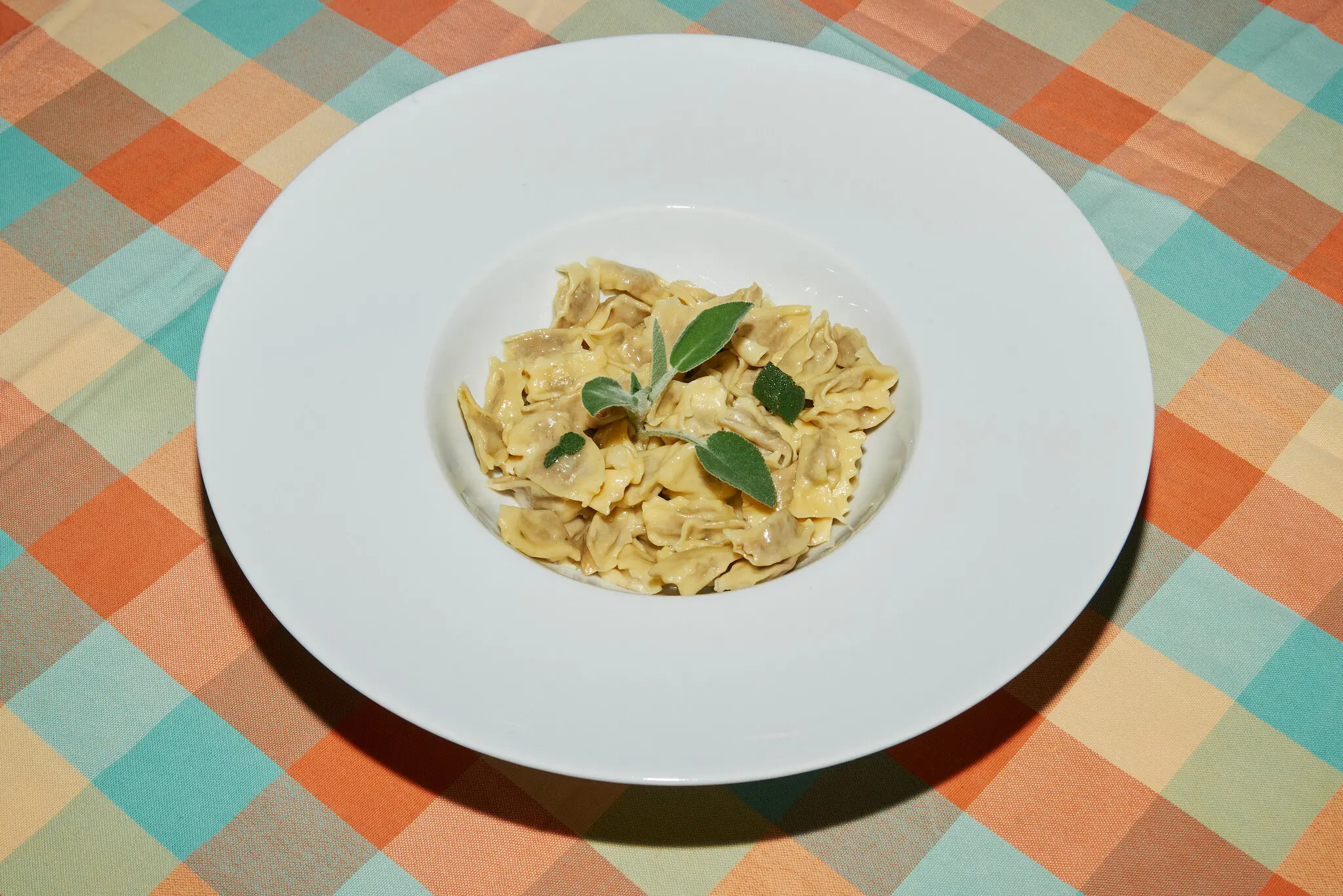
Overlooking the Bormida valley, Ristorante Madonna della Neve sits opposite the 16th-century chapel for which it’s named. With large windows framing bucolic views, its classic osteria ambience is echoed in its menu of time-honored dishes. While agnolotti is a term used for many kinds of stuffed pasta, especially in Italy’s northwestern Piedmont region, it’s the agnolotti del plin — penny-size filled pasta that’s named for the pinch with which it’s sealed (“pinch” is plin in the Piedmontese dialect) — that are the real star. The manager, Piermassimo Cirio, whose grandparents opened Ristorante Madonna della Neve in 1952 and who sometimes heads up the kitchen, says that meeting the demand for agnolotti del plin requires a full day of filling and folding each week from a crew of staff and family members. And for many guests, the pasta — which is filled with a mixture of ground veal, pork and rabbit, Parmigiano-Reggiano, rosemary and borage — is, in itself, a multicourse meal. Start with the version served al tovagliolo, meaning on a linen napkin without sauce, allowing the gentle sweetness of the filling’s leafy greens to shine. Follow with agnolotti with sage and butter or, more bracingly, sage and lemon juice (Cirio’s invention). Next, try them with a sauce of Bolognese-ish ragù or, as an alternative, the juices and tender scraps of a beef roast (arrosto). For a final course, order a small bowl of agnolotti doused with Barbera wine. Suggested wine pairing: Isolabella della Croce Maria Teresa Barbera d’Asti 2022. — Robyn Eckhardt
2 Reg. Madonna della Neve
Roberta Corradin: I grew up in Piedmont and homemade agnolotti with a roasted meat filling is mandatory.
Karima Moyer-Nocchi: Madonna della Neve is an incredible experience.
Stefano Secchi: I was just there last year and it’s fantastic.
Davide Palluda: I took a picture with the almost 90-year-old [Piera Cirio, Piermassimo’s mother] a few years ago, and I asked her how many agnolotti she’s made in her life. I think a million. She has the forearms! She’s the one that [reminds] all the young chefs in Piedmont why we have to respect [the traditions]. The nicest way to have it is just boiled and naked, without sauce.
Moyer-Nocchi: Oh, yeah, that’s gorgeous. It’s homey and nurturing, and that humble way that it’s served makes it a transformative experience.

The Sicilian chef Ciccio Sultano calls the busiate, an elegant but sturdy corkscrew pasta shape that was historically formed by wrapping the dough around knitting needles (or the stem of a local grass), “matriarchal.” It’s a specialty of Trapani, on Sicily’s west coast, and usually served with pesto Trapanese: almonds, basil, garlic, tomatoes, pecorino, perhaps a touch of fresh mint. But at Duomo, a gastronomic institution in Ragusa Ibla, on the southern end of the island, Sultano goes much further, imbuing the pasta (always made in-house from heritage grains such as tumminia and perciasacchi) with intense local flavors. The busiate on the current menu features fragrant wild fennel and saffron and a ragù of glittering anchovies and mackerel. And to finish: grated red tuna heart. Another longtime favourite version, which resurfaces from time to time, is the busiate kneaded with rosewater and topped with plump, sweet Mazara prawns (pictured above). Opened nearly 24 years ago, Duomo, as the name suggests, sits in a handsome townhouse down the street from Ragusa Ibla’s dramatic Baroque cathedral, less than an hour from where Sultano took his first job in a kitchen, at a pastry shop, when he was just 13. Eating this dish, he suggests, evokes the island life, culinary influences via Sicily’s many centuries of invaders, from the Greeks and Arabs to the Normans, and the voluptuousness of a cuisine born of the sea. Suggested wine pairing: Pietradolce Archineri Etna Bianco 2018. — Marina O’Loughlin
31 Via Capitano Bocchieri
Corradin: Busiate are Sicily’s version of fusilli. In the western part of Sicily, they make long busiate, which are difficult to eat. If you’re a gentleman, the busiate will slap your tie. That’s the kind that Ciccio Sultano at Duomo makes. The rosewater he puts in the dough gives a hint of the region’s past, when it was under Arab domination. It bounces you back to another time.
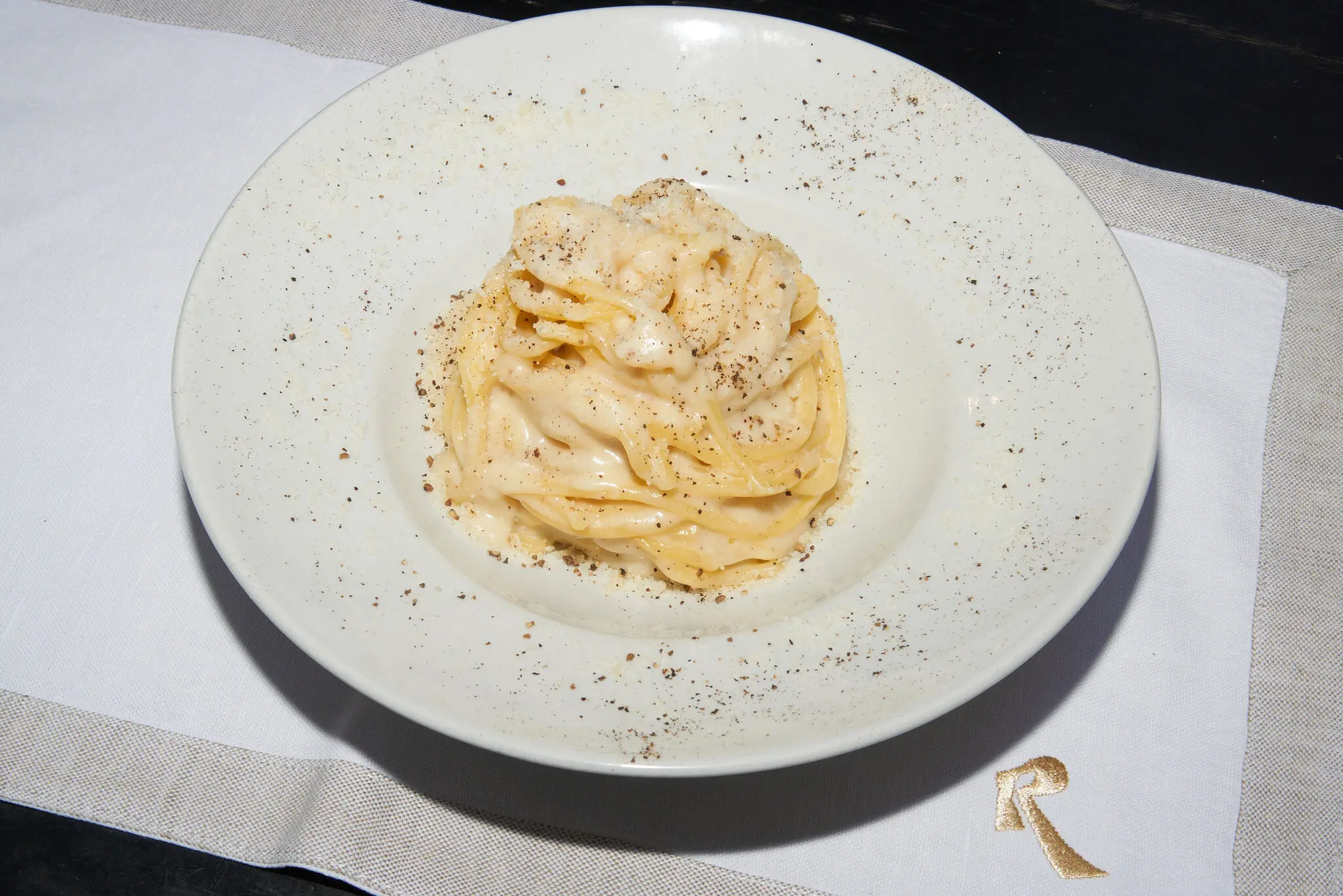
Made with only pasta, cheese and pepper, cacio e pepe seems downright simple, yet this classic Roman dish is mired with potential pitfalls: cooks know to beware the dreaded clumping. Not only does Roscioli Salumeria con Cucina make a perfect version, they’re unafraid to tweak it when necessary: If the pecorino is fresher, and so less intensely salty, the chefs use only that. If it’s older, they’ll perhaps add some Parmesan to temper the ferocity. Their special blend of ground black peppercorns — including the perfumed, potent Sarawak — makes this simple dish, prepared with tonnarelli (a spaghetti-like egg pasta), memorable. This, at a mere 20 years old, is one of the newer additions to the small Roscioli group of restaurants and bakeries in Rome (a pasticceria also opened 10 years ago). All are popular among tourists, but escaping the chaos of Campo dei Fiori for a seat at the counter here, a glass of red wine in hand, the cacio e pepe in front of you, feels like the real Rome. Suggested wine pairing: Damiano Ciolli Podere Ciriolino Cesanese di Olevano 2022. — M.O.
21 Via dei Giubbonari
Palluda: Cacio e pepe is easy to prepare but it’s not easy to make a good one. Roscioli cooks it the right way, with the right ingredients. If I have the chance I always go when I’m in Rome — if I can get in, it’s a small restaurant — and I always eat the cacio e pepe.

Though Rome is the Italian city most often associated with antiquity, carbonara — arguably the most popular of its classic pastas, which also include cacio e pepe, amatriciana and alla gricia — is actually a 20th-century innovation. The dish’s creator and exact place of origin are unknown, but an often-told story involves the arrival of Allied troops in Rome in 1944: The soldiers, or someone cooking for them, allegedly mixed eggs, powdered milk and bacon with pasta. Today, carbonara is usually made with eggs, guanciale (cured pork jowl), pecorino cheese, black pepper and spaghetti. Some chefs use only yolks while others add the whole egg. Some stick to pecorino while others mix in parmigiano. Some pair the sauce with rigatoni instead of spaghetti. Every chef in the city likely believes they make the best version, but the rigatoni alla carbonara at Ristorante l’Arcangelo — a white-tableclothed establishment near Vatican City — has earned its place among the essential dishes of Rome. The silky sauce, salty but not overpowering, evenly coats the rigatoni, pooling just enough in the bottom of the plate so you can dip a piece of bread at the end. The fresh eggs give the dish a vivid yellow hue, and the hefty, crisp pieces of guanciale are doled out with precision; it’s said that the chef personally counts the seven pieces allotted to each plate. Suggested wine pairing: Tenute Filippi Ipazia 2022. — Kristina Gill
59 Via Giuseppe Gioachino Belli
Moyer-Nocchi: I was really torn between including [head chef of Ristorante l’Arcangelo] Arcangelo Dandini’s carbonara or Nabil Hadj Hassen’s. When Nabil was the chef at Salumeria Roscioli, he won a national competition, in 2008, for the best carbonara in Rome. He left Roscioli after 18 years and now he’s at Baccano [also in Rome]. It was a close call between Dandini and Hassen. Post-Covid, when everyone was sitting around thinking about what they were going to do with their lives, Arcangelo made adjustments to the cheeses he uses in the dish. He now uses 80 percent Pecorino Romano sourced locally, from a particular milking. And he’s added 20 percent smoked pecorino di Gavoi from Sardinia, which for him recalls the time when smoking was one of the ways of preserving foods. And he uses these eggs — you’re going to have to trust me — these are just outstanding eggs with the creamiest egg yolks ever. He’s a miraculously inventive chef in the way that he pulls history into his modern iterations of dishes.
Corradin: The carbonara is very good at Arcangelo, and it’s in Prati, a nice bourgeois neighbourhood that I believe is also home to several kosher restaurants. It isn’t a place for tourists. Well, in Rome tourists are everywhere, but this is a classic location for real Roman families.
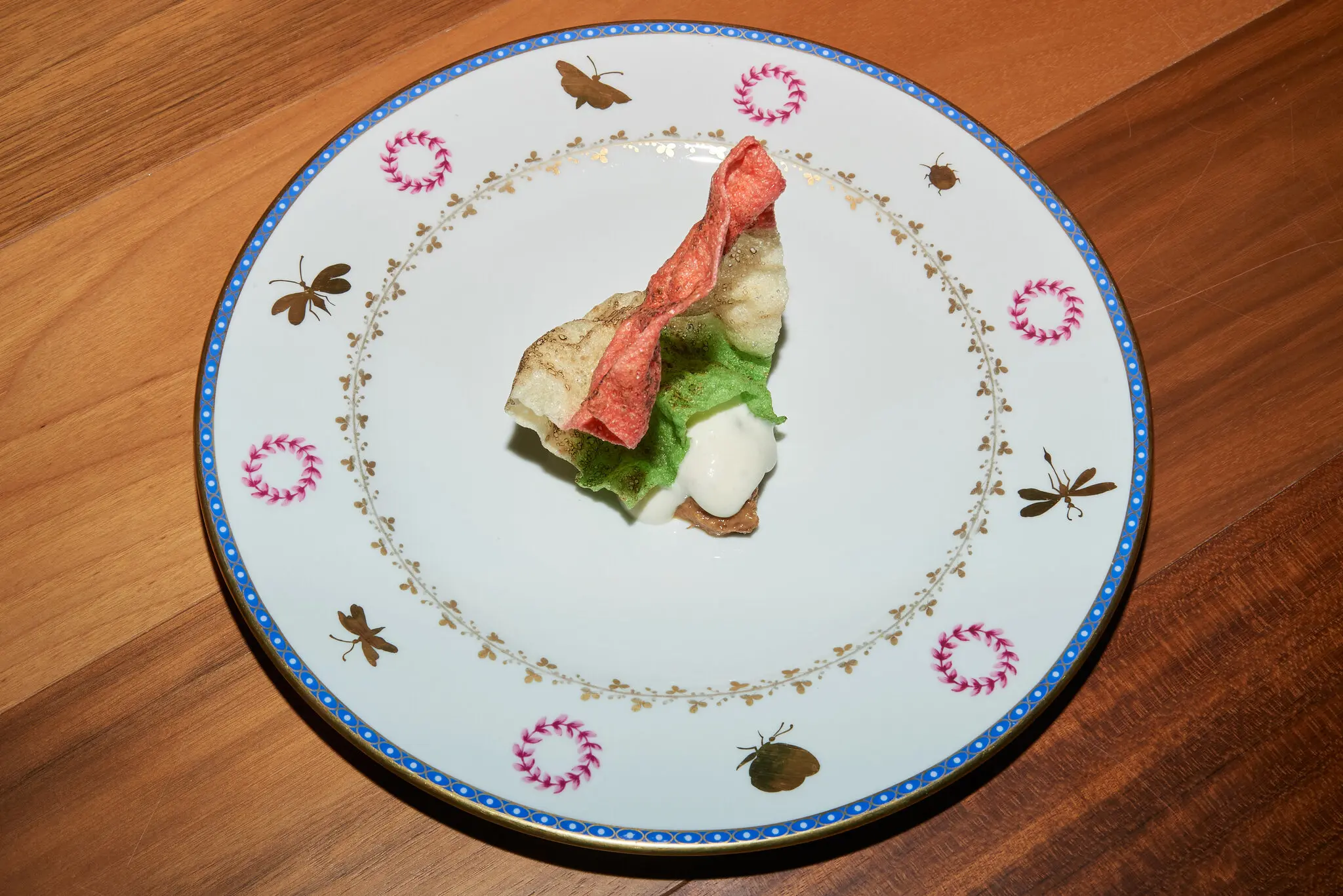
Though it’s served with a fork and spoon, it’s hard to keep your hands off the chef Massimo Bottura’s famous recreation of the coveted corner slice of lasagna. The crispy tower begs to be broken apart with your fingers, the rich ragù and aerated béchamel scooped up, nacho-like, from the plate. To make the dish, Bottura boils spaghetti and then purées it to form a dough, which is divided into three parts, each mixed with a different sauce: basil, Parmigiano-Reggiano or tomato. After being rolled out, the pasta sheets are fried, smoked, and, finally, lightly charred with a torch. The result is somehow both familiar and disorienting: “It’s about feeding people with emotions,” Bottura says. Originally, he served his postmodern take on the homey favourite at his Osteria Francescana, which opened in 1995, but these days it’s available only at Francescana at Maria Luigia, one of the restaurants at Casa Maria Luigia, the guesthouse he opened with his wife, Lara Gilmore, in 2019 in San Damaso, just outside the city of Modena. Here, the sole offering is a nine-course tasting menu comprising Bottura’s well-known dishes, served at communal tables facing an open kitchen. Suggested wine pairing: Comte Lafond Sancerre 2022. — Laurel Evans
56 Stradello Bonaghino
Secchi: I’m biased because I worked at Francescana and I know what it takes [to prepare this lasagna]. It takes three or four days to make. That ragù alone isn’t just made with traditional beef: There’s cheek and side, tongue and a special ingredient I can’t name because Massimo [Bottura] would kill me.
Palluda: Especially in the last 15 years, Massimo Bottura never stops talking about his region, Emilia-Romagna. One of the things he always says is to make good food in Italy, you have to stay with your feet on the land and your brain in the clouds. In his dishes with ragù, you can feel this point of view. Like a lot of guys in Emilia, he probably grew up with the smell of [the sauce] in the house. It’s very important that someone as famous as Bottura still talks about his ingredients and his history — it makes the people and the producers of that region really proud of their home.
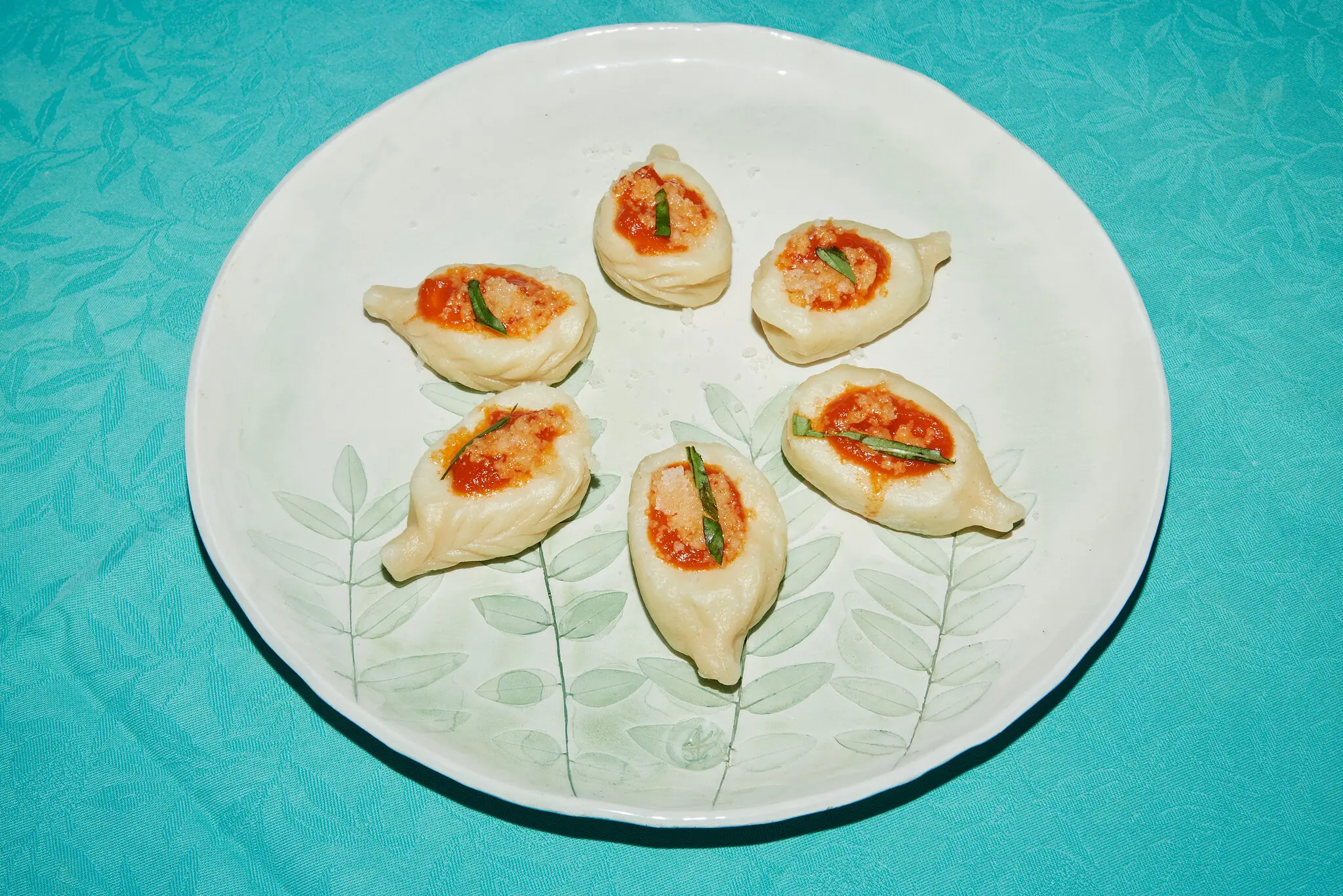
From April until October, Hotel Ristorante Ispinigoli serves reimagined Sardinian classics overlooking a patchwork of terraced vineyards, olive groves and fruit orchards that descend toward the Gulf of Orosei on the east coast of Italy’s second-largest island. Among the restaurant’s specialties are culurgiones, fresh pasta parcels filled with a blend of potato, cheese, garlic and mint that are pinched closed, the seams resembling ears of wheat. Native to the Ogliastra subregion of Sardinia that’s about a 90-minute drive south, culurgiones have transcended their hyperlocal origins and are now served across the island, though the filling proportions change from cook to cook. At Hotel Ristorante Ispinigoli, the chef Giovanni Cossu, along with the chef Gian Nicola Mula, leads a multigenerational family-run kitchen that plates them in a novel way: They don’t toss and coat their culurgiones with tomato sauce in the rustic fashion but rather crown each with a spoonful, then top with a dusting of pecorino. Suggested wine pairing: Cantina Tani Taerra Vermentino di Gallura 2022. — Katie Parla
125 Strada Statale
Secchi: This restaurant has been in the family for three generations. It’s about an hour and a half from where my family is from and it has one of the best views in Sardinia. One of the chefs [the nephew of the head chef Cossu] used to work at Osteria Francescana [see No. 5]. He’s cooking traditional pasta, but also doing contemporary things because of his time at high-end restaurants on mainland Italy. I thought he’d go chase the stars, but it’s just the opposite — he wanted to bring everything he learned back home.

Genoa, the city that lends its name to this meaty pasta sauce, is a good 400 miles from Naples, the place best known for it. Every local seems to have a different origin story for the dish, including the tale that credits Swiss mercenaries for bringing this slow-cooked beef and onion sauce to the southern Italian city sometime around 1495. Though it’s commonly ladled onto short cylindrical pasta shapes such as paccheri or rigatoni, at Coco Loco, which opened in the middle of Naples’s historic centre in 1995, the chef and owner, Diego Nuzzo, prefers to use mezzanelli, a longer, skinnier version of ziti. He models his Genovese after the recipe used by monzù, private cooks to the city’s aristocracy in the 18th and 19th centuries who applied French culinary techniques to regional ingredients. Like the monzù, Nuzzo braises the beef shank and lots of red onions in lard rather than olive oil, intensifying the flavour of both ingredients. He then adds white wine, a few cubes of pork and simmers the sauce for up to five hours, adding a little tomato paste toward the end “just to give a touch of colour.” But the real secret to the dish, he says, is to choose a dried pasta that doesn’t release too much starch (he prefers the Garofalo brand) to keep the sauce from getting too gluey. Suggested wine pairing: Quintodecimo Terra d’Eclano Irpinia Aglianico 2015. — Lee Marshall
4 Vicoletto Cappella Vecchia
Palluda: It’s difficult to explain to people that this is a [Neapolitan] dish and the name Genovese only refers to the people who moved from Genoa to Napoli. In Genoa, you usually get a pesto condimento [sauce]. Here, it’s a lot of meat and the protagonist of this recipe is the onions. You just colour the onion with tomatoes.
Corradin: It’s one of the many geographically confusing dishes in Italian cuisine — like zuppa inglese; inglese means “English” and it’s not English at all. And it’s not a soup at all, it’s dessert. [We call them] false friends.
Moyer-Nocchi: It’s a fabulous dish. That five-hour braise renders something that tastes like a sweet, beef-flavoured onion butter that loses whatever negative connotations onions have and becomes a larger-than-the-sum-of-its-parts dish. Diego Nuzzo is the most renowned for [pasta alla Genovese] and [he serves it] in a really elegant setting.
Corradin: And unlike most pastas, in Napoli, pasta alla Genovese is served as a main course.
8. The Minestra di Pasta Mista With Shellfish and Rockfish at La Torre del Saracino
Vico Equense, Campania
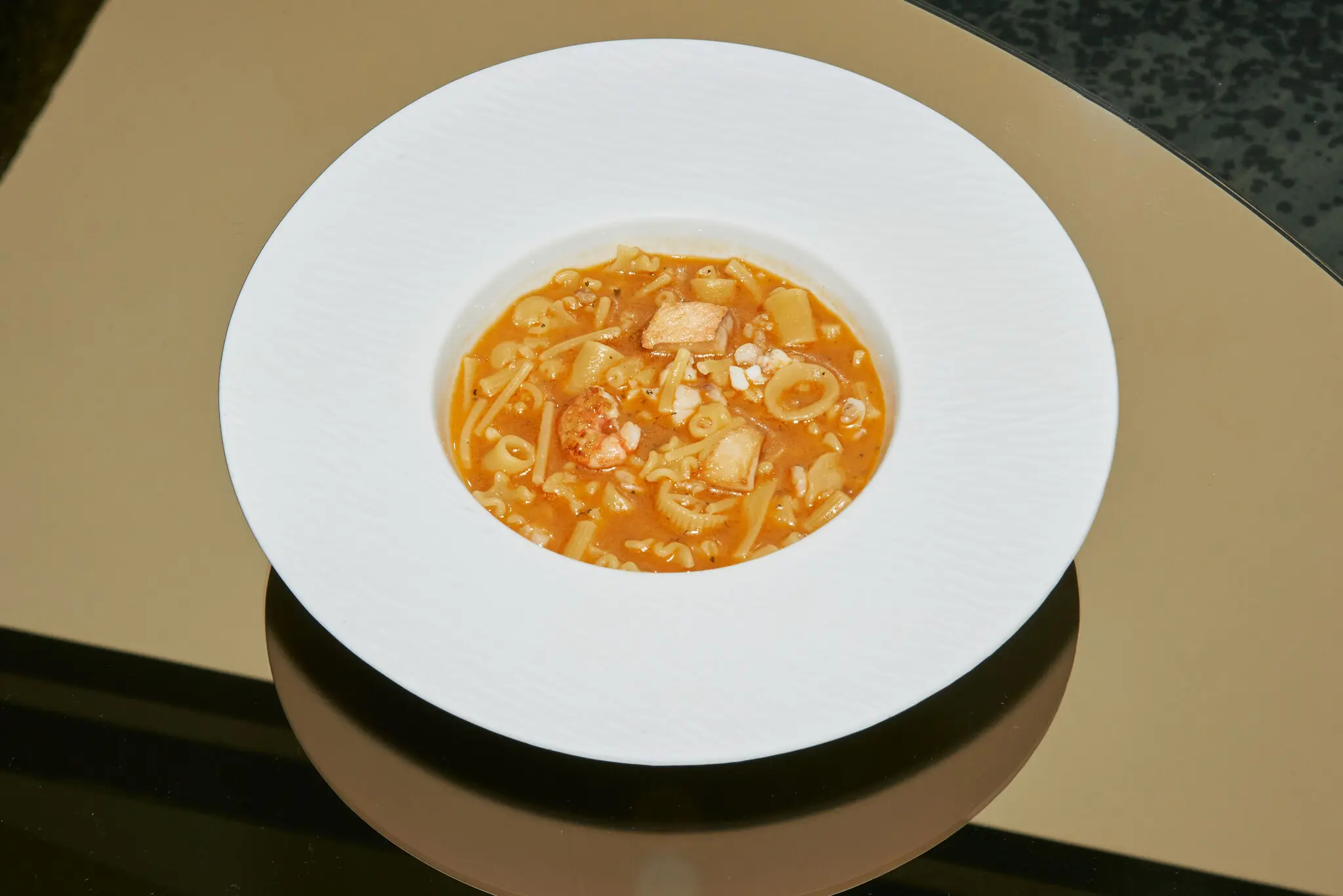
A meal at La Torre del Saracino, in the seaside town of Vico Equense, is something of a ceremony. It begins in a Medieval watchtower overlooking the Bay of Naples where you’re welcomed with an aperitif (a sparkling Franciacorta, for example) and small bites (perhaps a free range-chicken cacciatora panino) while listening to music chosen by guests from the chef Gennaro Esposito’s vinyl collection, with plenty of 20th-century Neapolitan pop and jazz. Then you’re led down a winding stone staircase to a 20-seat main dining room with high arched windows overlooking the sea. The minestra di pasta mista con crostacei e pesci di scoglio, one of Esposito’s signature dishes, is a nod to the fish soup that the 54-year-old chef, a native of Vico Equense, grew up eating. In those days, it was made mostly with the catch that couldn’t be sold at the markets and typically took hours to prepare. Now, at La Torre del Saracino, it’s a symbol of gleeful abundance: Esposito uses more than a pound and a half of Mediterranean rockfish, shrimps, squid and prawns to make one portion. Still one of the more time-consuming dishes in his repertoire, it involves slow-cooking the rockfish in a light fish stock, then squeezing them in a French duck press to retain the juices. Once all the seafood and San Marzano tomatoes are left to simmer on the stove top, for several hours, he adds a mix of as many as 15 different pasta shapes, both tubes and spirals (families traditionally made minestre like this to use up those annoying bottom-of-the-package leftovers). The pasta is left to cook in the soup so that, in Esposito’s words, “it absorbs all its goodness.” Suggested wine pairing: Mastroberardino Stilema Fiano di Avellino 2015. — L.M.
9 Via Torretta
Palluda: Gennaro Esposito is one of the new generation of chefs from Campania, from Napoli. Twenty-five years ago, it wasn’t so easy to introduce new ideas in Campania — it seemed like you were fighting with tradition, but that’s not why he did it. He learned a lot of new techniques in France [and elsewhere] and then used products that were close to him. He made new recipes without losing the identity of the original one. A lot of young chefs followed him. His minestra pasta is a very interesting dish. You mix in a lot of types of pasta. Every spoonful is different. Like chocolate, you never know what you’re going to get. It’s a very rustic dish, but very technical.
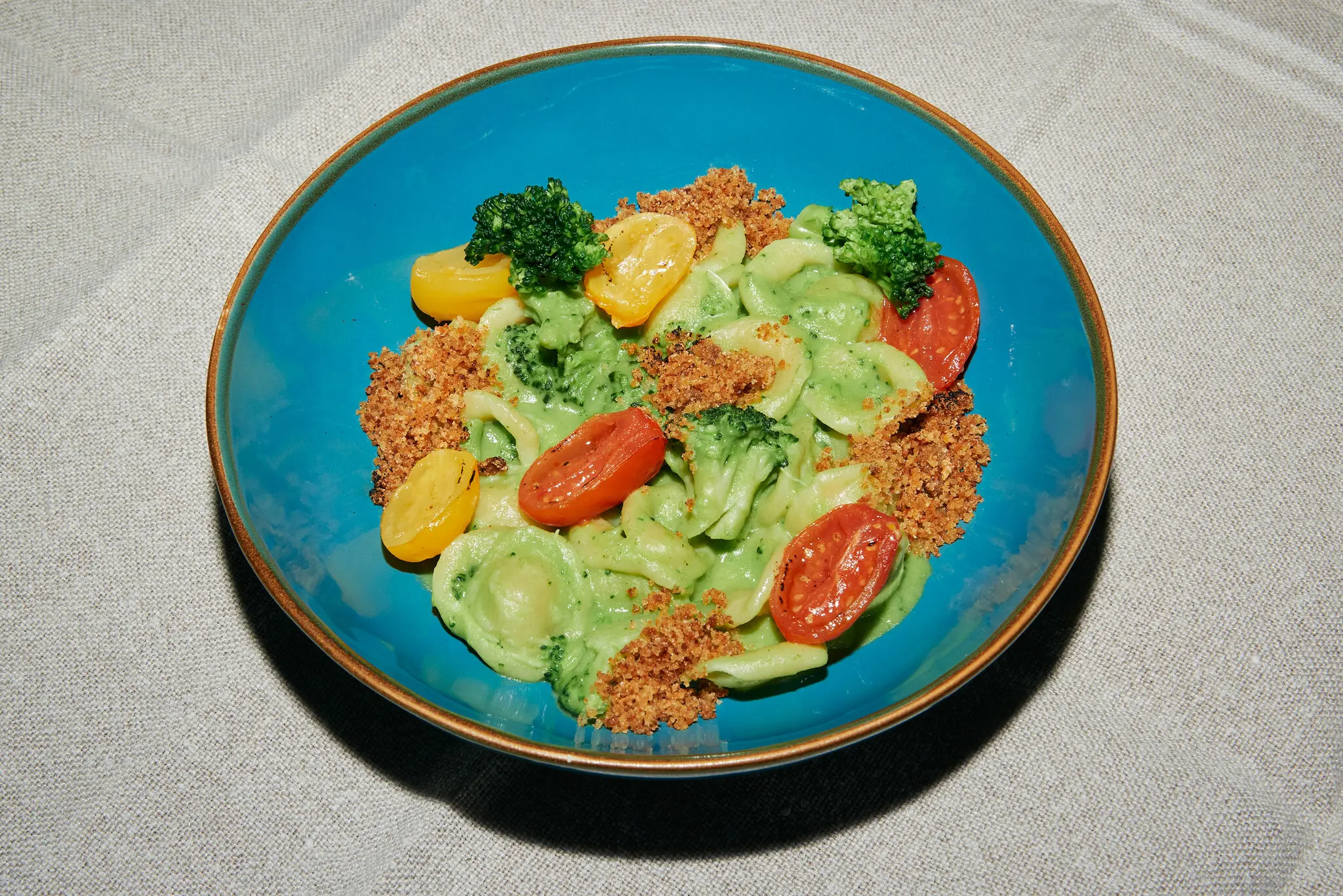
If you find yourself wandering the whitewashed back streets of a Pugliese town, you’ll likely encounter women gathered near the stoops of their houses, forming semolina flour dough into quarter-size orecchiette, which they leave to dry on netted boxes balanced atop wooden stands. Shaped vaguely like an earlobe (the name translates to little ear) orecchiette is often served with ragù or turnip greens, but among the most beloved variations is one made with broccoli. In Milan, some 550 miles to the north of Italy’s heel, the chefs Antonella Ricci and Vinod Sookar have created their own version of the recipe at the Pugliese-inflected mainstay Ricci Osteria, which opened in 2022. Usually, the dish is made by sautéing parboiled broccoli with garlic, anchovies and mildly spicy pepperoncini in extra virgin olive oil; theirs also includes sweet, soft confit tomatoes. The finishing flourish is a generous sprinkling of crunchy toasted bread crumbs, which serve as the ideal foil to the orecchiette’s chewy texture. Suggested wine pairing: a 2020 negroamaro from Agricola Felline. — Laura May Todd
27 Via Pasquale Sottocorno
Moyer-Nocchi.: Antonella Ricci is from Puglia and her husband and partner in the restaurant [Vinod Sookar] is from Mauritius. And together they really represent Milan. [The city] is a micro-melting pot in Italy that since the end of World War II has pulled in a great exodus from the rural south, because that’s where the jobs were, and then later, a great influx of people of Sri Lankan and Indian origin. It’s good to see a person of colour in the position of chef as well, because Italy’s restaurants would not go on without this population.
Palluda: It’s a dish made with briciole [breadcrumbs], which is something you usually throw away. They call it the poor man’s Parmesan. And with these scraps, they’ve built this amazing dish.

What happens when a restaurant with such fine-dining pedigree takes on pasta with tomato sauce, one of the simplest of all the primi? You get a creamy, almost velvety rendition that’s become the calling card for Da Vittorio, a luxurious fixture of the northern city of Bergamo since 1966. In the early 2000s, Vittorio Cerea and his family, including his son, the current head chef, Enrico “Chicco” Cerea, moved the restaurant from the historic core of the city to a villa surrounded by parkland, less than five miles outside of town. From there, Enrico expanded the menu, offering innovative dishes like scampi with fermented miso and tempura sardines with a lemon sauce. But diners who come from Milan — about 30 miles to the southwest — and much farther (there’s a heliport and a hotel on the property) often have just one item on their mind: the paccheri alla Vittorio. A cork-size tubular pasta, paccheri are served here slightly al dente and swimming in a sauce made with three types of tomatoes, basil, olive oil and sautéed garlic, thickened at the end with butter and Parmesan. The dish, offered as part of an eight-course tasting menu, also comes with a bib — you’re invited to mop up the sauce with freshly baked farro bread. Suggested wine pairing: Vie di Romans Chardonnay 2020. — Eric Sylvers
17 Via Cantalupa
Palluda: It’s cooked like risotto, meaning that you cook it for just 80 percent of the time in the water, and then you finish the dish directly in the [sauce], and they do that at the table in front of the people.
Secchi: [They serve] it convivio, family-style, which is a beautiful way to do it.
Moyer-Nocchi: What makes the dish so worthy of this list is the sauce. My advice: Opt for the bib.
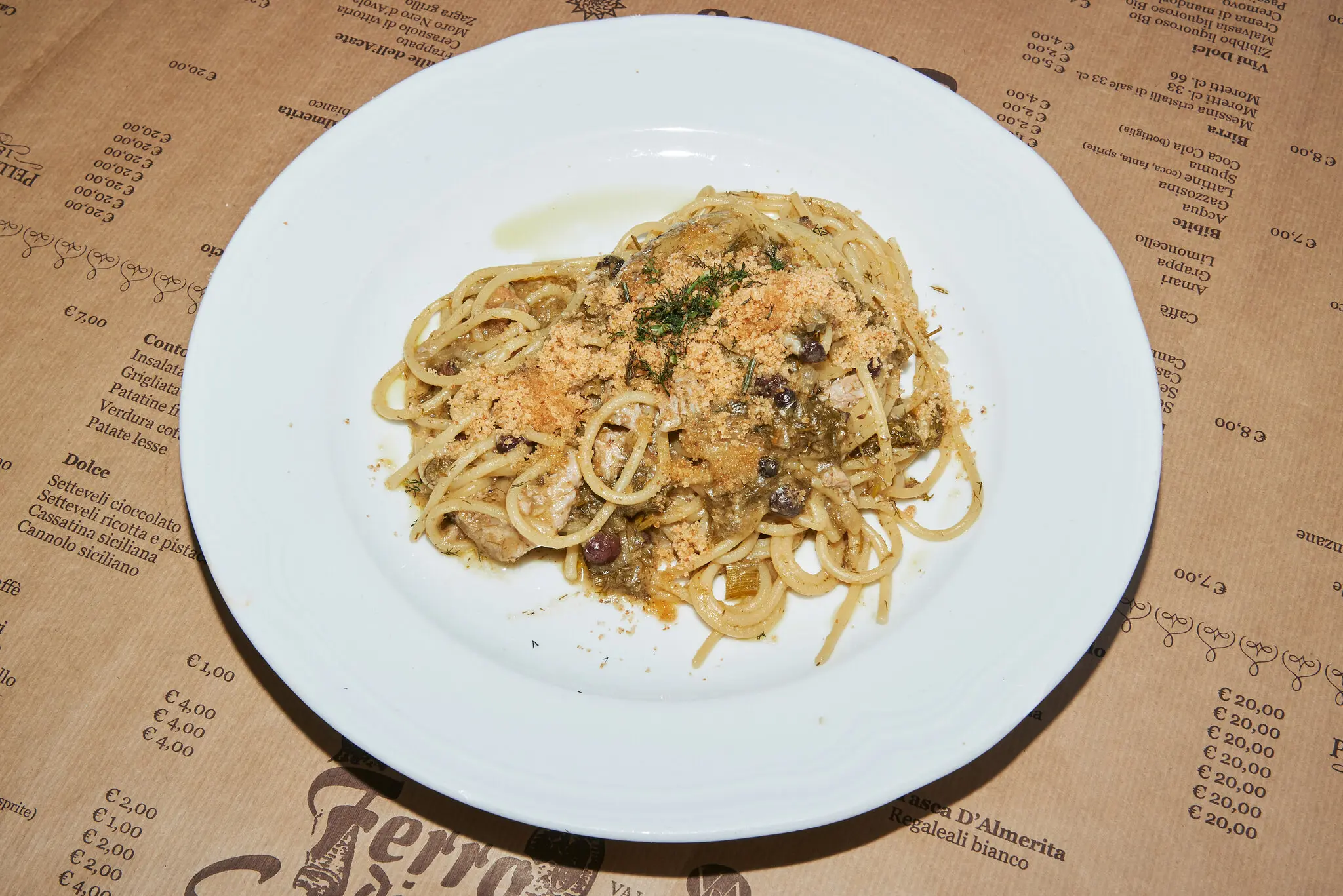
When your massive portion of pasta con le sarde at Trattoria Ferro di Cavallo in Palermo is set in front of you, your first thought is likely, “What is this mess of gloopy spaghetti covered with greenish-brown sauce?” But it’s precisely the dish’s aggressively ugly appearance that makes the first bite — and smell — so surprising. The rustic recipe is full of all the contradictions and complexities inherent to Sicilian cooking: High-end ingredients like plump sweet raisins and resinous pine nuts mix with sardines, the poorest of fish, barely boned, to form more of a stew than a pasta sauce; it’s also redolent of wild fennel. The warm, chaotic Trattoria Ferro di Cavallo, which opened in 1944 and is in the heart of the old city, doesn’t take reservations, but with the two big rooms inside, and the large covered terrace outside, you’ll rarely have to wait long. Suggested wine pairing: Tasca d’Almerita Regaleali Bianco 2022. — Elizabeth Minchilli
20 Via Venezia
Moyer-Nocchi: Pasta con le sarde doesn’t get as much attention as it should. Ferro di Cavallo puts a lot of care into it. They have an investment in the tradition of this dish. It’s a very colourful, classic trattoria.

Some pasta dishes demand you put aside restraint. Pizzoccheri certainly qualify — the fettuccine-like buckwheat pasta is typically tossed together with copious amounts of Valtellina Casera cheese and butter, potatoes and a vegetable (usually cabbage). Said to be born at least 200 years ago at the foot of the Alps in Valtellina — a valley that runs east from the northern shores of Lake Como — the hearty dish is still the perfect thing to eat at Quattro Stagioni, with its exposed beams, simple wooden chairs and stone fountain in the middle of the main dining room. The restaurant is part of the La Fiorida agriturismo, a working farm that doubles as a country inn, with 29 guest rooms, some 500 animals (mainly cows, goats and sheep), a cheese-making facility and 150 acres of cultivated fields. While the buckwheat is sourced from a nearby farm, nearly everything else used in the pizzoccheri comes from on site. This means that, depending on the time of year, you might find spinach or Swiss chard in your pizzoccheri. “There is no exact recipe because it’s always changing,” says the head chef, Gianni Tarabini. Suggested wine pairing: Nino Negri Inferno Valtellina Superiore 2019. — E.S.
12 Via Lungo Adda
Moyer-Nocchi: Very few pasta dishes use non-wheat flours but the pizzoccheri of Valtellina, made with mostly buckwheat, has been awarded European Union P.G.I. [Protected Geographical Indication] certification, bringing it into the panoply of Italy’s most highly valued traditional dishes. It’s a deeply comforting pasta.
Davies: I love pizzoccheri.
Palluda: I just don’t know if American people know about pizzoccheri.
Davies: Maybe that’s why it should be on the list.
Moyer-Nocchi: La Fiorida makes an excellent pizzoccheri, and it’s a beautiful agriturismo. Very small, local everything.

The faded grocery store sign still hangs above the door of Maggese in the ancient Tuscan hill town of San Miniato. Step into the small retro-modern interior, glance to the right and there, behind a two-seater counter, you’ll usually find Fabrizio Marino, fielding orders and greeting clients. Opening a vegetarian restaurant in meat-oriented Tuscany back in 2019 was a risk, Marino admits. But he needn’t have worried: Maggese books out days in advance. Rasnal — which he says means “of the Etruscans” — is a soup that’s been a fixture on the Maggese menu from the beginning. It pairs slow-braised seasonal vegetables — some foraged, some cultivated — like wild asparagus and artichoke with a sauce of local red heirloom beans. The dish’s pasta component consists of just four simple, bite-size eggless-pasta parcels made from heirloom flour. Their fillings can change with the seasons — they might be celeriac or chickpeas, pumpkin or carrot — but they always deliver a sweet note to balance the broth’s bitterness. Suggested wine pairing: Il Borghetto Montigiano Sangiovese 2019. — L.M.
29 Via IV Novembre
Davies: I love everything that they do at this restaurant. It’s in my town, San Miniato. We’re in the middle of a place that is very, very well known for red meat. They used to have seven butcher shops in this small town.
Palluda: They eat the vegans there.
Davies: When Maggese opened, it was like this breath of fresh air because everything they do is vegetarian. The owner and head chef [Marino] is from a nearby town and there are a few Japanese chefs [in his kitchen], and they often use ingredients like miso within their dishes. Not in a really obvious way; you just get this little kick of umami. This minestra [reminds me] of pasta e fagioli. When it arrives at the table, the pasta and the soup are separate so you can tip the pasta into the soup or you can eat them separately. It’s a joy.
14. The Ravioli With Ricotta, Walnuts and Burnt Garlic at Oasis Sapori Antichi
Vallesaccarda, Campania

Since the day it opened in 1988, Oasis Sapori Antichi, in the rural town of Vallesaccarda, a two-hour drive east of the Amalfi Coast, has had ravioli with ricotta, walnuts and burnt garlic on the menu. It’s a dish of happenstance: Founder Giuseppina Fischetti neglected a pan on the stovetop and a sauce was born. This could so easily be another accidental origin story, charming but entirely forgettable; but, more than three decades later, it’s become the cornerstone of an exceptional kitchen. Now in the hands of Giuseppina’s five children and grandchildren (both in the kitchen and front of house), Oasis Sapori Antichi focuses primarily on the ingredients grown just outside town, in the territory of Irpinia with its great natural resources. The garlic used in their sauce — toasted, rather than burnt, until it has a savoury toffee-like flavour — is blended with the area’s malizia walnuts and olive oil produced by the Fischetti family less than a mile from the front door. The ravioli is also made daily and filled with local cow’s milk ricotta and flecks of minced parsley. The restaurant itself looks like a slightly theatrical living room, with its scattering of Persian rugs and tall candlesticks. But while the service is formal and elegant, the family’s natural ease warms the room. Suggested wine pairing: Boccella Rosa Taurasi Aglianico 2015. — Rachel Roddy
8/10 Via Provinciale
Corradin: The garlic tastes more smoky than burnt. I first had it 14 years ago, and I spent part of my life thinking about when I could go back. I’ve been back several times since.
Palluda: No one has said that to me in my life.
Corradin: The dream of each and every chef.
15. The Spaghetti all’Assassina at Al Sorso Preferito
Bari, Puglia

A few years ago, if you had asked anyone outside of Bari about spaghetti all’Assassina they’d have given you a blank stare. The dish was so specific to the capital of Puglia that only one or two restaurants served it. The method, which was handed down to Pierino Lonigro, the owner of the town’s Al Sorso Preferito, by the supposed inventor of this dish, in the 1960s, involves cooking the spaghetti into a tomato sauce filled with pepperoncini until the mixture forms a crust that’s spicy and slightly crispy. It’s a difficult technique to get right, but Lonigro credits his well-seasoned cast-iron pan that he’s been using for decades. He bought the restaurant in 1974; that same year, he moved it to its current location in the elegant Murat neighbourhood. Most locals start with the mixed antipasto, an array of raw and cooked seafood, before having the Assassina. Legend has it that the name of this dish came from the fact that the spiciness of the sauce almost killed customers, though Lonigro’s version, a nice balance of sweetness and mild heat, presents very little danger. Suggested wine pairing: Paololeo Alture Susumaniello 2020. — E.M.
40 Via Vito Nicola De Nicolò
Moyer-Nocchi: While the concept is easy enough, it takes an experienced hand to produce the desired effect: crispy, fiery spaghetti. Al Sorso Preferito may be an unassuming, few-frills restaurant, but it’s the mecca for this dish.

When you order spaghettone all’amatriciana at Santo Palato near the Basilica di San Giovanni in Rome, the servers tell you that it will take at least 15 minutes. This is both a courtesy and reassurance that the thick spaghetti will be boiled to order, not always the case in a city where, more often than you might imagine, the reliance on precooked pasta keeps service swift, but means the dishes can often lack texture. Santo Palato is a small trattoria, simply furnished and decorated with Futurist-style posters, the daily specials chalked-up on a blackboard. The chef and owner, Sarah Cicolini, sources the spaghettone from a Roman pasta maker called Pastificio Lagano, and the jarred cherry tomatoes from Agricola Paglione, a farm in Puglia. The pigs’ cheek guanciale and the sheep’s milk Pecorino Romano cheese she chooses are also from small producers. One of the four canonical Roman pasta dishes, amatriciana is the sum of these four parts, which Cicolini — often visible through an opening into the kitchen — brings together expertly. Suggested wine pairing: Cantina Ribelà Saittole 2020. — R.R.
4 A/B Piazza Tarquinia
Secchi: When I first went there, about seven years ago, Sarah was one of the very few women in this new avant-garde of Roman chefs, and she was cooking offal, which had always been butch men territory.
Moyer-Nocchi: Santo Palato is a seamless combination of an old trattoria and modern design and it reflects Sarah’s approach to the way she reconceptualises traditional Roman food.
Secchi: She cooks all the four classic Roman pastas and she does it damn well.

Tortelli di zucca, a winter squash stuffed pasta, is made a little differently throughout Lombardy but perfected at Dal Pescatore, outside of Mantova (the dish’s supposed birthplace), in the village of Runate. Much can go wrong with this seasonal pasta (at its best in autumn), from the inclusion of amaretti cookies at some places to the addition of strange, mustardy candied fruits at others; it can be too sweet, too spicy, too sour or otherwise unbalanced. Perhaps worst of all, the dish can be oversauced, with a creamy topping drowning out the flavor and texture of the pasta. But at Dal Pescatore, the chefs Nadia and Giovanni Santini have made tortelli the centrepiece: from the slight bite of the outer rim to the tender interior that encloses the filling. The five pieces they provide — which aren’t so much coated with as touched by butter and Parmigiano-Reggiano — are just enough. Suggested wine pairing: Ca’ del Bosco Annamaria Clementi Franciacorta 2015. — Andrew Sean Greer
15 Riserva del Parco Oglio Sud
Secchi: It’s in the middle of nowhere, but they have a helicopter pad there, so people from Milano fly in and have dinner. That place is an institution.
Corradin: The first time I went to Dal Pescatore, Nadia realised I was sick and she cooked me tortellini en brodo [tortellini in broth]; after that, I could’ve eaten a 25-course meal. But I agree with Stefano that the iconic dish there is tortelli di zucca.
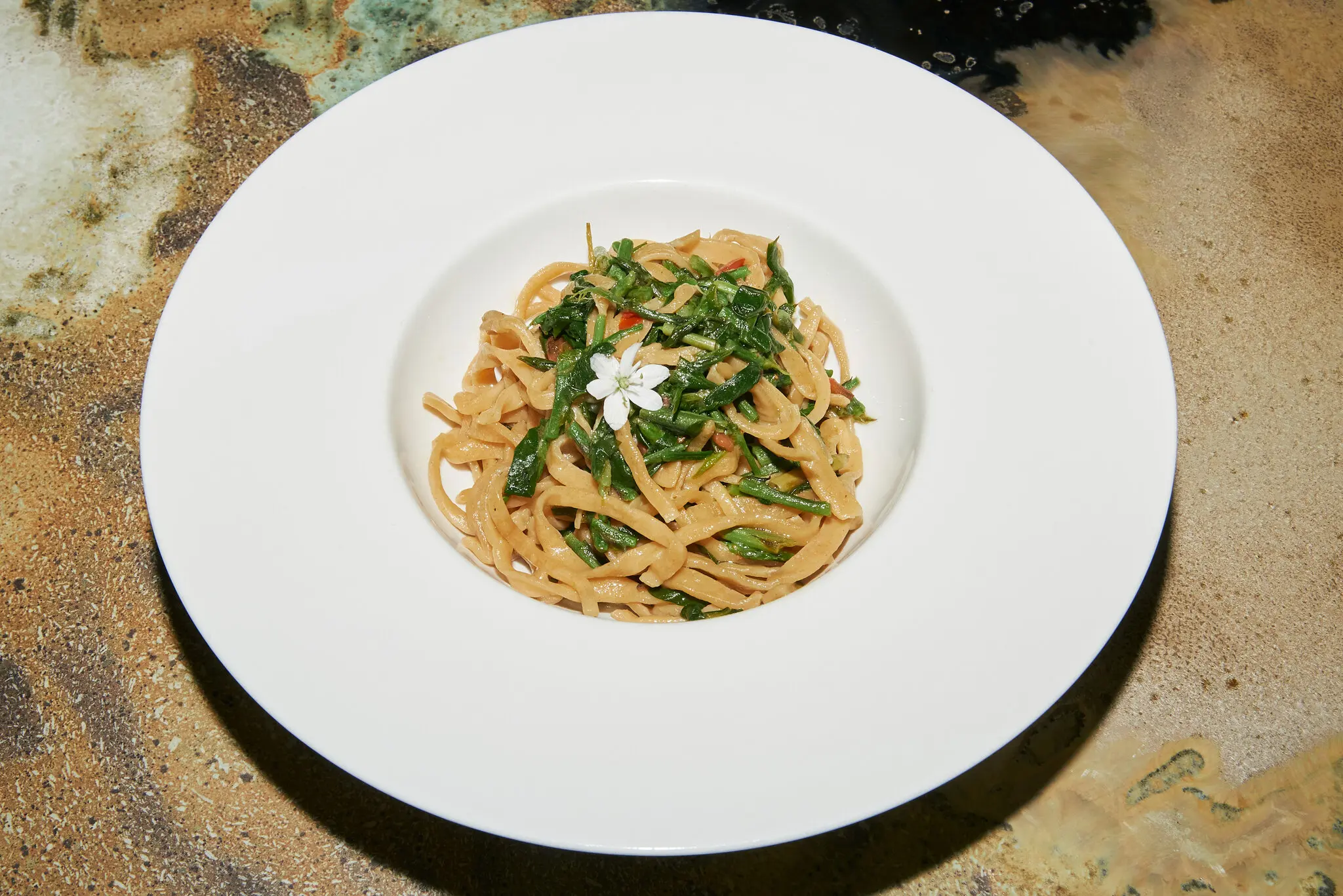
At first glance, strangozzi looks like spaghetti. But unlike that more ubiquitous pasta, which tends to originate in factories, the slightly chubbier strangozzi are hand-rolled, hand-pulled and mostly found in central Italy. At L’Alchimista, established in 2001 in the medieval Umbrian hill town of Montefalco, the chef and co-owner Patrizia Moretti makes it the old-fashioned way: with just water and extra-fine “00” wheat flour, which makes them pleasantly chewy. Go in the warm weather and you’ll likely be seated at an outdoor table in what might be one of Italy’s prettiest piazzas. This, too, is the time of year Moretti serves the pasta with tender greens foraged from nearby fields or with a pesto, made from two of the greens and wild garlic. If you come in summer, you might find your plate of strangozzi tossed with zucchini and in fall, topped with black truffles. Suggested wine pairing: a young trebbiano Spoletino from Tenuta Bellafonte. — E.M.
14 Piazza del Comune
Davies: When I was last there, there was a strangozzi with wild herbs — [ones] no one will have ever heard of that you collect in the Umbrian countryside. It’s just a very simple dish but it’s special. One is called strigoli and another is vitalba, whose English names are not very appetising (bladder campion and old man’s beard). They’re herbs that need to be picked young and have been foraged for centuries — it’s a really ancient sort of dish.

Cibrèo Caffè, the more informal outpost of a small, influential group of restaurants near Mercato Sant’Ambrogio (the locals’ preferred traditional food market), opened in 1983, and it’s still one of Florence’s most inviting places to stop in for a negroni and a snack (say, a pizzetta). But those in the know head straight for the cacio e burro. Here, the ultimate comfort food — pasta doused in melted butter and cheese — is approached with the same earnestness you might expect of fussier fare: Butter, Parmigiano-Reggiano and hot milk are blended together with enough force that it forms a paste, which melts into a cream on contact with the hot pasta — at Cibrèo, it’s tagliolini, the narrower, more delicate sibling of tagliatelle. Its yolk-yellow color, and faint sweetness, comes from the unlikely addition of boiled carrots into the purée. Suggested wine pairing: Podere Erica l’Erica Rosé Sangiovese 2022. — M.O.
5r Via Andrea del Verrocchio
Corradin: If we mention Cibrèo, we have to mention the tagliolino cacio e burro.
Secchi: Oh, I agree.
Emiko Davies: Cibrèo is my go-to restaurant in Florence. My husband worked there, as the head sommelier, but he doesn’t anymore. The cacio e burro is still one of my favourite dishes there. Fabio Picchi [the founder of Cibrèo who died in 2022] cheekily called it “rubato,” stolen, because it’s a revisitation of another iconic Florentine dish, the taglierini gratinati from Harry’s Bar, a favourite since the 1950s.
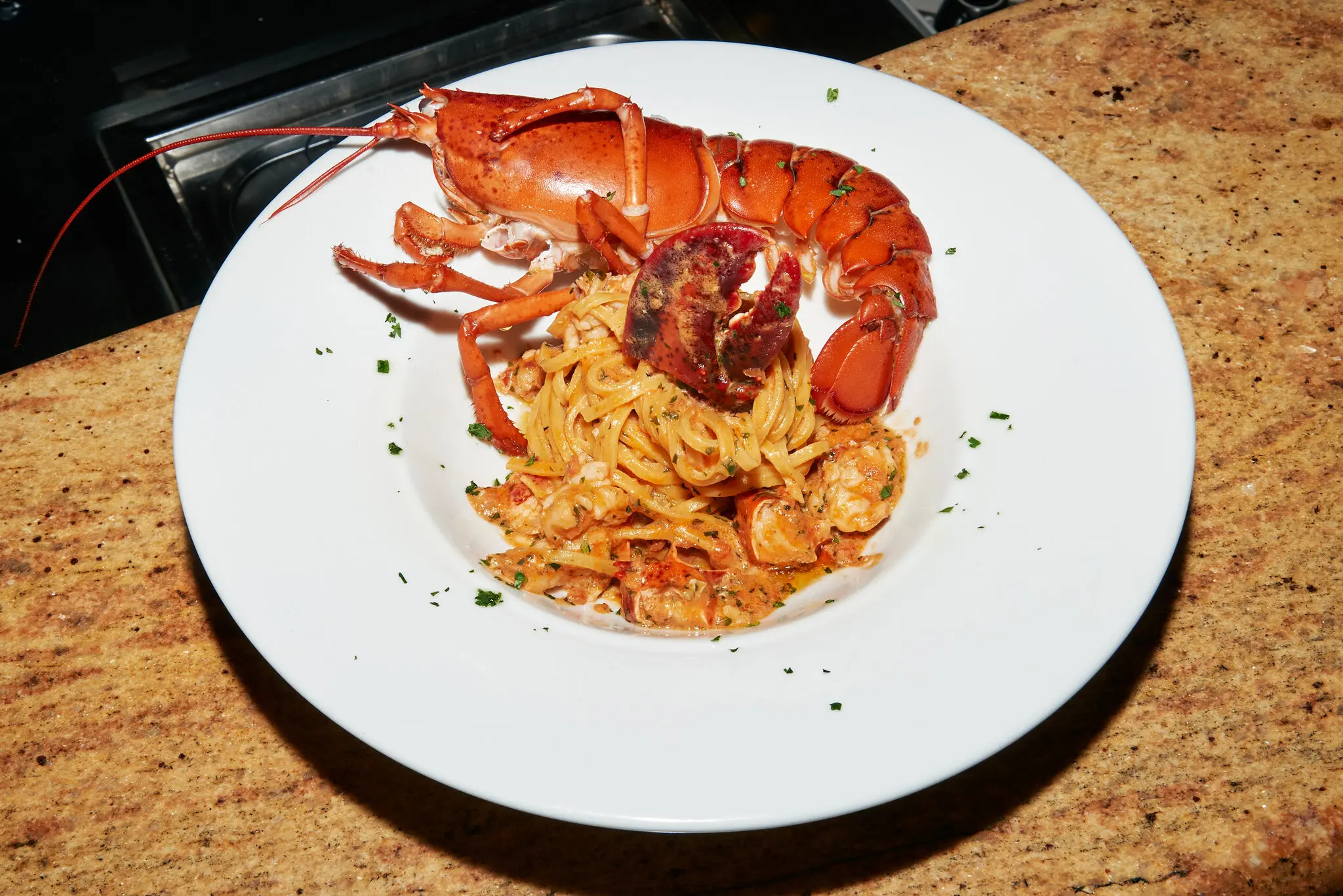
Set atop a steep hill on a particularly dramatic stretch of Italian coastline, Corniglia is considered the quietest of the touristy Cinque Terre villages. When you finally reach town, after climbing a 382-step brick stairway up a rocky cliff from the train station (or taking the shuttle bus), you’ll be ready for a large plate of pasta. Ristorante Cecio in Corniglia — which has been family owned and operated since 1976 — is the place to find it. The menu revolves around local seafood that’s sourced daily and pasta dishes by the head chef, Gabriele Pittavini, who’s honed his craft over the 20 years he spent operating a fresh pasta shop. One favourite is the tagliolini all’astice, a thin, homemade egg pasta with lobster, available for a minimum of two people. At first glance, it’s a flamboyant dish: a cherry-red claw reaches straight up from the ribbons of pasta, adorned with fat morsels of pink meat and a sprinkling of parsley. Half a lobster fills one side of the plate. Upon tasting it, however, you’ll find it showcases the fresh ingredients without overembellishing them. Be sure to reserve a table outside: The view from the veranda alone justifies a visit. Suggested wine pairing: Cinque Terre DOC 2023. — L.E.
58 Via Serra
Davies: I’ve been going here with my family for well over a decade — we love the Cinque Terre but it’s changed a lot and this trattoria has always stayed the same. The seafood is incredibly fresh. There’s nothing like a summertime dinner there.

Gemma Boeri has been hand-rolling and cutting tajarin pasta for the locals in Roddino, a small town in southern Piedmont, for almost four decades. “Why would I stop? This is what I know how to do,” she says. The large glass window connecting the dining area of her hilltop trattoria with the prep room affords a view of Boeri and her helpers preparing the long, skinny strands of egg pasta (similar to spaghetti but with a golden hue), while the outside-facing windows overlook the Langhe hills known for producing quality food and wine, including Barolo. Boeri serves the tajarin (the Piedmontese word for tagliolini, a thinner version of tagliatelle) with a thick beef ragù sauce, which she says has won over diners because it reminds them of the comfort food they enjoyed when they were kids. “There’s no secret, I just prepare the food like nonna used to,” she says. It can take several months to get a reservation. Yet da Gemma has nonetheless remained relaxed and unpretentious: its walls lined with photos dating back to when Boeri first started serving customers in 1986. She serves only a single fixed menu that, in addition to the tajarin, includes Piedmontese classics, such as beef tartare and agnolotti del plin, the area’s signature stuffed pasta (see No. 1). Suggested wine pairing: Agricola Gianpiero Marrone La Pantalera Barbera d’Alba Superiore 2020. — E.S.
6 Via Guglielmo Marconi
Palluda: Every month I go see Gemma just to kiss her hand. It’s true, I’m not joking. She’s our pope.
Secchi: Her place is in the mountains. It’s very hard to get to, and it’s very blue-collar. When you sit down to eat, everything is served family-style, and the amount of food that comes to your table is … I mean, completely unnecessary. Gemma is like the original nonna. A few times a week, all the nonnas in the village come to roll pasta with her, and then they all sit down together for lunch. How does that tradition carry on when her time passes? There’s got to be a way.

Salumeria Giusti, in operation since at least 1605, is reported to be the world’s oldest delicatessen, but that’s not its only claim to fame. Beyond the antique wood and marble counter a hallway leads to a tiny dining room with only four tables. Reservations here are among Modena’s most coveted, especially after the restaurant, a favourite of locals for decades, was featured on the Netflix series “Master of None” in 2017. Daniele Morandi, whose grandparents opened Hosteria in 1989, is in charge of the pasta making. He rolls out each sheet of dough by hand with a long wooden pin and shapes every raviolo and tortellino with skill and speed he learned from his grandmother. Among his most popular offerings are tortelloni — pillowy larger versions of typical Modenese tortellini — filled with a mix of local ricotta, aged Parmigiano-Reggiano, spinach and freshly grated nutmeg. Bathed in an emulsion of pasta water and unpasteurised French butter, the dish is a study in simplicity. (Lunch only, though dinner can be prearranged for groups of 12 or more.) Suggested wine pairing: Corte d’Aibo Spungola Sauvignon Blanc 2022. — L.E.
75 Via Luigi Carlo Farini
Secchi: I worked there when I first moved to Modena, but only after I went to 30 different places to taste fresh pasta. In terms of technique and ambience, Giusti blew my mind. And that tortelloni? I think the ricotta is still warm when it’s delivered to the kitchen. It just disintegrates in your mouth.

In a bland, busy neighbourhood not far from Bologna’s exhibition center, Al Cambio has been drawing a business crowd during weekday lunches and couples and families for dinner and on weekends for the past three decades. After booking weeks in advance, they file into the spare, white and beige dining room, debate the offerings on the extensive wine list (dominated by varieties from the Emilia-Romagna region) and settle in for a long lunch or dinner of local specialties, from breaded veal cutlets and mortadella to sformatino (a type of potato soufflé). But the most ordered — and scrutinized — dish is the one that bears the city’s name: lasagna alla Bolognese. Like most places in town, Al Cambio offers a seven-layer lasagna made with jade-green spinach noodles sandwiched between coats of béchamel and ragù. But Al Cambio’s ragù is meatier than most, made with beef minced together with prosciutto and pork sausage, and then topped with a thick layer of the ragù, the “final flourish,” as the manager Piero Pompili says: “It’s our way of symbolizing Bologna’s food heritage.” Suggested wine pairing: San Patrignano Avi Sangiovese di Romagna Superiore Riserva 2019. — Vicky Bennison
150 Via Stalingrado
Stefano Secchi: People are going to have a lot of opinions about where to find the best [lasagna alla Bolognese in Bologna], but for me, this is it. It has the perfect amount of crispness and gooeyness.
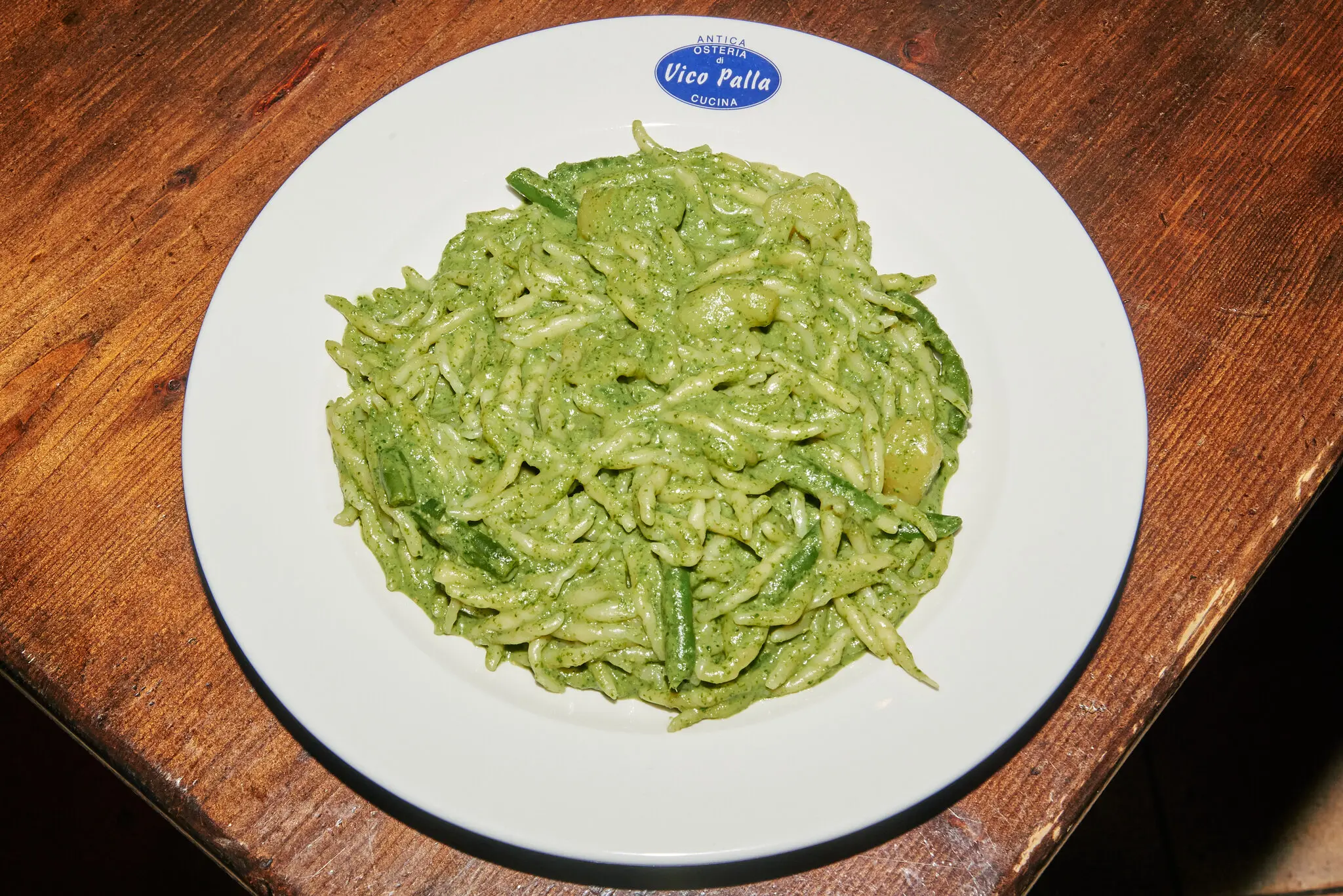
Pesto alla Genovese — the pungent bright green sauce made from basil, extra-virgin olive oil, Parmigiano-Reggiano, pecorino, pine nuts, garlic and salt — can be tossed with almost any shape of pasta, from spaghetti to fusilli. Its most authentic pairing, however, is trofie, a short, hand-twisted noodle typical of Recco, just down the coast from Genoa. It’s here that the most commonly known pesto originated (what’s thought to be the earliest printed recipe appeared in the 1863 book “La Cuciniera Genovese”), and at Antica Osteria di Vico Palla the dish is served at its most elemental. The rustic restaurant — where patrons sit at simple wooden tables laid with brown paper place mats under vaulted brick ceilings that date back to the 1500s — serves its trofie pesto mixed with boiled potatoes and green beans, as local families have for generations. The menu changes daily; ask for this dish if you don’t see it. Suggested wine pairing: a young vermentino di Albenga from the Ligurian coast. — Marianna Cerini
15/r Vico Palla
Palluda: You can’t have a list of Italian dishes without pesto. It’s the most popular condimento in the world. It’s very light, it’s modern, and it’s easy to make. If you want to blend it, instead of making it with a mortar, and you want to make a good, lively pesto, you really should have cold ingredients.
Corradin: In Genoa, poor people added potatoes and green beans to their pasta with pesto to make it a piatto unico, richer in nutrients but still affordable. [It’s common] to eat it scarpetta, the Italian ritual of scraping up the remaining sauce with bread. But here you use potatoes instead of bread. The beauty of this kind of dish and this kind of trattoria is that they’re both reminders that, in Italy, you don’t have to be rich to enjoy a good meal.

Photo editor: Lauren Poggi
Research editor: Alexis Sottile
Copy editor: Magnus Schaefer
A correction was made on
May 17, 2024
An earlier version of this article misidentified the restaurant where Nabil Hadj Hassen was the chef in 2008; it was Salumeria Roscioli, not Antico Forno Roscioli.
Tourists tend to flock to Macerata, a small hilltop city in the eastern part of the Marche region, for two reasons: The summer opera festival and the decidedly unsummery seven-layer baked pasta dish known as vincisgrassi. Letizia Carducci, one of the three siblings who have been running the 30-seat Osteria Dei Fiori, which opened in 1980 on a cobblestone street close to the main square, says the dish evolved from princisgras, a pasta casserole made with black truffles and prosciutto that was served to the local nobility in the 18th century. In the Marcerate province, resourceful housewives made a ragù using meat from various farmyard animals, including bones and offal; that’s the recipe that Iginia and her brother, Paolo (they cook; their sister Letizia is the maitre’d), have built on to make their vincisgrassi, which consists of duck, chicken, rabbit and a little pork. Dessert wine, vino cotto, also plays a key role: It’s added to the dough that the Carduccis knead into silk-thin pasta sheets, then used to saute the chicken and duck livers, which are stirred into the sauce at the very end. The meaty ragù covers the four bottom layers, while the top one is reserved for the nutmeg-inflected béchamel sauce. Baked in an oven, the whole thing is both earthy and luxurious, with subtle hints of smoke. Suggested wine pairing: Gàjole Verdicchio di Matelica 2021. — V.B.
61 Via Lauro Rossi
Secchi: What is vincisgrassi? I’ve never had it.
Corradin: It’s Macerata’s ancestral lasagna. One story says that it’s named for an Austrian officer named Windisch-Graetz who was stationed in Macerata province around the early 1800s.
Moyer-Nocchi: Lasagna has become a specific dish, associated with a specific place. The Maceratese prefer not to call their dish a lasagna, even though it, too, is a rich, layered pasta dish.
Palluda: When these dishes were born, there were no computers [people didn’t sit all day] and no radiators. They stayed warm with a fire, but with the food also. They expended calories to stay warm. People ate just one meal every day.
Moyer-Nocchi: Historically, you’d only eat these things once or twice a year. It’s not like you’d be picking these dishes off a menu every day. In the meantime, you’d be eating much more frugally: cabbage, beans, leafy greens.
Palluda: Somebody said to me, “Why don’t you make some of these traditional pastas lighter?” But that’s not the right way to respect the dishes. We can make the portions smaller, but you need to keep the flavour.
